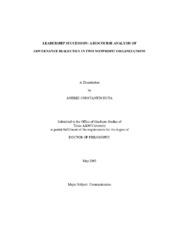| dc.description.abstract | Nonprofit organizations across the country are faced with a leadership crisis due
to unprecedented demographic changes and challenges. The en masse retirement of the
baby boomers leaves leadership positions in nonprofit organizations vacant and
vulnerable. This study uses discourse analysis and dialectical theory to compare and
contrast the leadership succession processes in two Texas-based nonprofit organizations.
Both organizations have comparable missions, religious backgrounds, and annual
budgets. In addition, the two organizations share similar structures in terms of board of
directors, board chair, and executive director (ED) dynamics.
This research is a descriptive comparative case study. The specific purpose of
this study is to examine how various board members, including the board chair and the
incumbent ED, construct the leadership succession process through their discursive
interactions and strategies. This study demonstrates that leadership succession in
nonprofits is a convoluted process enacted discursively by conflicting or collaborating
key organizational actors huddled around various leadership nuclei. These nuclei include, in various combinations, the EDs, board chairs, vice-chairs, and even spouses of
some of these actors. The leadership nuclei morph over time, based on the management
of dialectical tensions experienced across four stages in the succession process: presuccession,
during succession A and B, and post-succession.
This research contributes to the larger body of leadership succession knowledge
in multiple ways. First, this study reveals that leadership is an amorphous and dynamic
concept contested among organizational actors across time. Second, the study highlights
the architectonic role of discourse in the leadership succession process. The succession
process is enacted through the key organizational actors' discursive exchanges. Third,
this research points to three types of dialectical tensions underlying the actors' discursive
interactions: individual-centered dialectics ("staying/leaving"), relation-centered
dialectics ("blaming/absolving," "freedom/control," and "cooperation/competition"), and
organization-centered dialectics ("change/stability"). Next, this study demonstrates that
organizational or individual crisis prompts the succession process, and that change,
conflict, goals, and deadlines grow out of the succession process and not the other way
around. Finally, this study contributes specifically to the research area of small
nonprofit organizations. There is a paucity of research examining the succession process
in small nonprofits, and this study addresses this need. | en |


